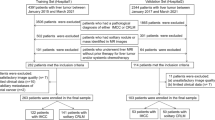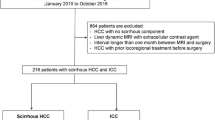Abstract
Objectives
To determine imaging hallmarks for distinguishing intrahepatic mass-forming biliary carcinomas (IMBCs) from hepatocellular carcinoma (HCC) and to validate their diagnostic ability using Bayesian statistics.
Methods
Study 1 retrospectively identified clinical and imaging hallmarks that distinguish IMBCs (n = 41) from HCC (n = 247) using computed tomography (CT) and magnetic resonance imaging (MRI). Study 2 retrospectively assessed the diagnostic ability of these hallmarks to distinguish IMBCs (n = 37) from HCC (n = 111) using Bayesian statistics with images obtained from a different institution. We also assessed the diagnostic ability of the hallmarks in the patient subgroup with high diagnostic confidence (≥ 80% of post-test probability). Two radiologists independently evaluated the imaging findings in studies 1 and 2.
Results
In study 1, arterial phase peritumoral parenchymal enhancement on CT/MRI, delayed enhancement on CT/MRI, diffusion-weighted imaging peripheral hyperintensity, and bile duct dilatation were hallmarks indicating IMBCs, whereas chronic liver disease, non-rim arterial phase hyperenhancement on CT/MRI, enhancing capsule on CT/MRI, and opposed-phase signal drop were hallmarks indicating HCC (p = 0.001–0.04). In study 2, Bayesian statistics-based post-test probability combining all hallmark features had a diagnostic accuracy of 89.2% (132/148) in distinguishing IMBCs from HCC for both readers. In the high diagnostic confidence subgroup (n = 120 and n = 124 for readers 1 and 2, respectively), the accuracy improved (95.0% (114/120) and 93.5% (116/124) for readers 1 and 2, respectively).
Conclusions
Combined interpretation of CT and MRI to identify hallmark features is useful in discriminating IMBCs from HCCs. High post-test probability by Bayesian statistics allows for a more reliable non-invasive diagnosis.
Key Points
• Combined interpretation of CT and MRI to identify hallmark features was useful in discriminating intrahepatic mass-forming biliary carcinomas from hepatocellular carcinoma.
• Bayesian method-based post-test probability combining all hallmark features determined in study 1 showed high (> 90%) sensitivity and specificity for distinguishing intrahepatic mass-forming biliary carcinomas from hepatocellular carcinoma.
• If the post-test probability or the confidence was ≥ 80% when combining the imaging features of CT and MRI, the high specificity of > 95% was achieved without any loss of sensitivity to distinguish hepatocellular carcinoma from intrahepatic mass-forming biliary carcinomas.






Similar content being viewed by others
Abbreviations
- APHE:
-
Arterial phase hyperenhancement
- CT:
-
Computed tomography
- DWI:
-
Diffusion-weighted image
- HBP:
-
Hepatobiliary phase
- HCC:
-
Hepatocellular carcinoma
- IMBC:
-
Intrahepatic mass-forming biliary carcinoma
- MRI:
-
Magnetic resonance imaging
- PVP:
-
Portal venous phase
- T1WI:
-
T1-weighted image
- T2WI:
-
T2-weighted image
References
Chinchilla-López P, Aguilar-Olivos NE, García-Gómez J et al (2017) Prevalence, risk factors, and survival of patients with intrahepatic cholangiocarcinoma. Ann Hepatol 16:565–568
Massarweh NN, El-Serag HB (2017) Epidemiology of hepatocellular carcinoma and intrahepatic cholangiocarcinoma. Cancer Control 24:1073274817729245
Nakanuma Y, Kakuda Y (2015) Pathologic classification of cholangiocarcinoma: new concepts. Best Pract Res Clin Gastroenterol 29:277–293
Aishima S, Oda Y (2015) Pathogenesis and classification of intrahepatic cholangiocarcinoma: different characters of perihilar large duct type versus peripheral small duct type. J Hepatobiliary Pancreat Sci 22:94–100
Nagtegaal ID, Odze RD, Klimstra D et al (2020) The 2019 WHO classification of tumours of the digestive system. Histopathology 76:182–188
Ariizumi S, Yamamoto M (2015) Intrahepatic cholangiocarcinoma and cholangiolocellular carcinoma in cirrhosis and chronic viral hepatitis. Surg Today 45:682–687
Gera S, Ettel M, Acosta-Gonzalez G, Xu R (2017) Clinical features, histology, and histogenesis of combined hepatocellular-cholangiocarcinoma. World J Hepatol 9:300–309
Marrero JA, Kulik LM, Sirlin CB et al (2018) Diagnosis, staging, and management of hepatocellular carcinoma: 2018 practice guidance by the American Association for the Study of Liver Diseases. Hepatology 68:723–750
Lee SM, Lee JM, Ahn SJ, Kang HJ, Yang HK, Yoon JH (2019) LI-RADS version 2017 versus version 2018: diagnosis of hepatocellular carcinoma on gadoxetate disodium-enhanced MRI. Radiology 292:655–663
Esposito A, Buscarino V, Raciti D et al (2020) Characterization of liver nodules in patients with chronic liver disease by MRI: performance of the Liver Imaging Reporting and Data System (LI-RADS v.2018) scale and its comparison with the Likert scale. Radiol Med 125:15–23
Chen N, Motosugi U, Morisaka H et al (2016) Added value of a gadoxetic acid-enhanced hepatocyte-phase image to the LI-RADS system for diagnosing hepatocellular carcinoma. Magn Reson Med Sci 15:49–59
Asato N, Tsurusaki M, Sofue K et al (2017) Comparison of gadoxetic acid-enhanced dynamic MR imaging and contrast-enhanced computed tomography for preoperative evaluation of colorectal liver metastases. Jpn J Radiol 35:197–205
Moon JY, Kim SH, Choi SY, Hwang JA, Lee JE, Lee J (2018) Differentiating malignant from benign hyperintense nodules on unenhanced T1-weighted images in patients with chronic liver disease: using gadoxetic acid-enhanced and diffusion-weighted MR imaging. Jpn J Radiol 36:489–499
Li J, Wang J, Lei L, Yuan G, He S (2019) The diagnostic performance of gadoxetic acid disodium-enhanced magnetic resonance imaging and contrast-enhanced multi-detector computed tomography in detecting hepatocellular carcinoma: a meta-analysis of eight prospective studies. Eur Radiol 29:6519–6528
Li J, Li X, Weng J et al (2018) Gd-EOB-DTPA dynamic contrast-enhanced magnetic resonance imaging is more effective than enhanced 64-slice CT for the detection of small lesions in patients with hepatocellular carcinoma. Medicine (Baltimore) 97:e13964
Liu X, Jiang H, Chen J, Zhou Y, Huang Z, Song B (2017) Gadoxetic acid disodium-enhanced magnetic resonance imaging outperformed multidetector computed tomography in diagnosing small hepatocellular carcinoma: a meta-analysis. Liver Transpl 23:1505–1518
Joo I, Lee JM, Lee DH, Jeon JH, Han JK (2019) Retrospective validation of a new diagnostic criterion for hepatocellular carcinoma on gadoxetic acid-enhanced MRI: can hypointensity on the hepatobiliary phase be used as an alternative to washout with the aid of ancillary features? Eur Radiol 29:1724–1732
Kim DH, Choi SH, Kim SY, Kim MJ, Lee SS, Byun JH (2019) Gadoxetic acid-enhanced MRI of hepatocellular carcinoma: value of washout in transitional and hepatobiliary phases. Radiology 291:651–657
Vernuccio F, Cannella R, Meyer M et al (2019) LI-RADS: diagnostic performance of hepatobiliary phase hypointensity and major imaging features of LR-3 and LR-4 lesions measuring 10-19 mm with arterial phase hyperenhancement. AJR Am J Roentgenol 213:W57–W65
Mavros MN, Economopoulos KP, Alexiou VG, Pawlik TM (2014) Treatment and prognosis for patients with intrahepatic cholangiocarcinoma: systematic review and meta-analysis. JAMA Surg 149:565–574
Adam SZ, Parthasarathy S, Miller FH (2015) Intrahepatic cholangiocarcinomas mimicking other lesions. Abdom Imaging 40:2345–2354
Murakami T, Tsurusaki M (2014) Hypervascular benign and malignant liver tumors that require differentiation from hepatocellular carcinoma: key points of imaging diagnosis. Liver Cancer 3:85–96
Kim R, Lee JM, Shin CI et al (2016) Differentiation of intrahepatic mass-forming cholangiocarcinoma from hepatocellular carcinoma on gadoxetic acid-enhanced liver MR imaging. Eur Radiol 26:1808–1817
Choi SH, Lee SS, Kim SY et al (2017) Intrahepatic cholangiocarcinoma in patients with cirrhosis: differentiation from hepatocellular carcinoma by using gadoxetic acid-enhanced MR imaging and dynamic CT. Radiology 282:771–781
Sheng RF, Zeng MS, Rao SX, Ji Y, Chen LL (2014) MRI of small intrahepatic mass-forming cholangiocarcinoma and atypical small hepatocellular carcinoma (</=3 cm) with cirrhosis and chronic viral hepatitis: a comparative study. Clin Imaging 38:265–272
Kim SA, Lee JM, Lee KB et al (2011) Intrahepatic mass-forming cholangiocarcinomas: enhancement patterns at multiphasic CT, with special emphasis on arterial enhancement pattern--correlation with clinicopathologic findings. Radiology 260:148–157
Park HJ, Kim YK, Park MJ, Lee WJ (2013) Small intrahepatic mass-forming cholangiocarcinoma: target sign on diffusion-weighted imaging for differentiation from hepatocellular carcinoma. Abdom Imaging 38:793–801
Haradome H, Unno T, Morisaka H et al (2017) Gadoxetic acid disodium-enhanced MR imaging of cholangiolocellular carcinoma of the liver: imaging characteristics and histopathological correlations. Eur Radiol 27:4461–4471
McHugh ML (2012) Interrater reliability: the kappa statistic. Biochem Med (Zagreb) 22:276–282
Jeong HT, Kim MJ, Chung YE, Choi JY, Park YN, Kim KW (2013) Gadoxetate disodium-enhanced MRI of mass-forming intrahepatic cholangiocarcinomas: imaging-histologic correlation. AJR Am J Roentgenol 201:W603–W611
Kudo M, Izumi N, Ichida T et al (2016) Report of the 19th follow-up survey of primary liver cancer in Japan. Hepatol Res 46:372–390
Funding
The authors state that this work has not received any funding.
Author information
Authors and Affiliations
Corresponding author
Ethics declarations
Guarantor
The scientific guarantor of this publication is Utaroh Motosugi.
Conflict of interest
The authors of this manuscript declare no relationships with any companies whose products or services may be related to the subject matter of the article.
Statistics and biometry
One of the authors (Daiki Tamada in University of Yamanashi) has significant statistical expertise.
Informed consent
Written informed consent was waived by the Institutional Review Board.
Ethical approval
Institutional Review Board approval was obtained.
Methodology
• retrospective
• cross sectional study
• multicenter study
Additional information
Publisher’s note
Springer Nature remains neutral with regard to jurisdictional claims in published maps and institutional affiliations.
Rights and permissions
About this article
Cite this article
Ichikawa, S., Isoda, H., Shimizu, T. et al. Distinguishing intrahepatic mass-forming biliary carcinomas from hepatocellular carcinoma by computed tomography and magnetic resonance imaging using the Bayesian method: a bi-center study. Eur Radiol 30, 5992–6002 (2020). https://doi.org/10.1007/s00330-020-06972-w
Received:
Revised:
Accepted:
Published:
Issue Date:
DOI: https://doi.org/10.1007/s00330-020-06972-w




